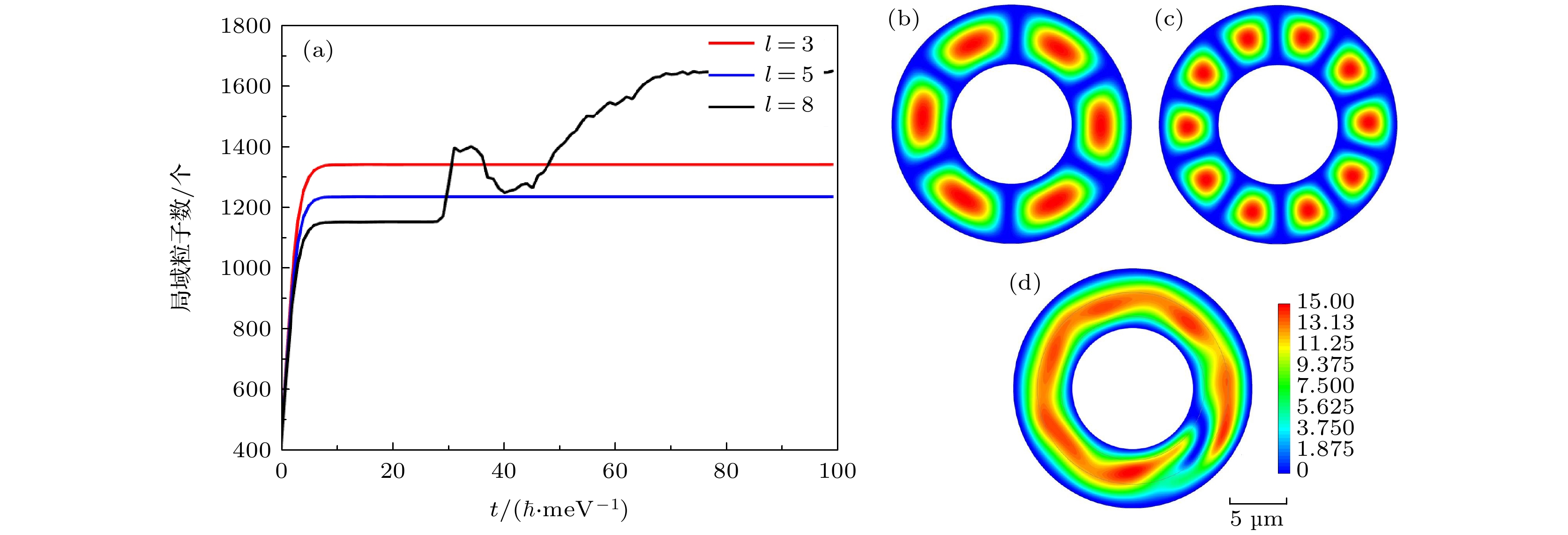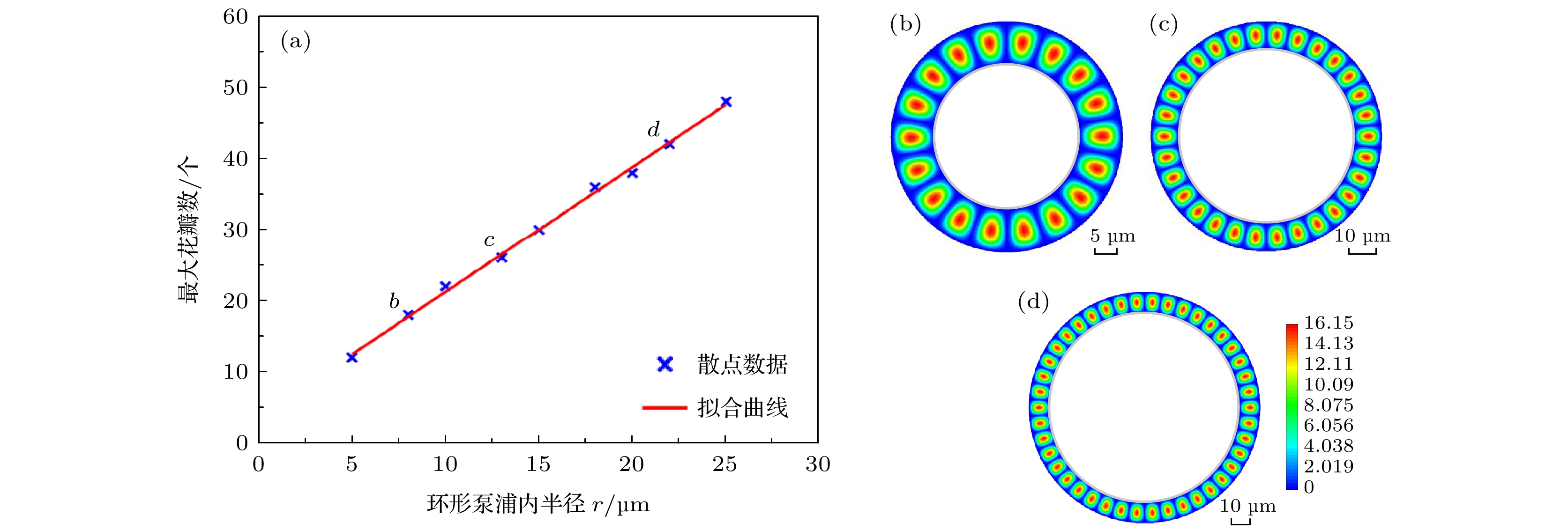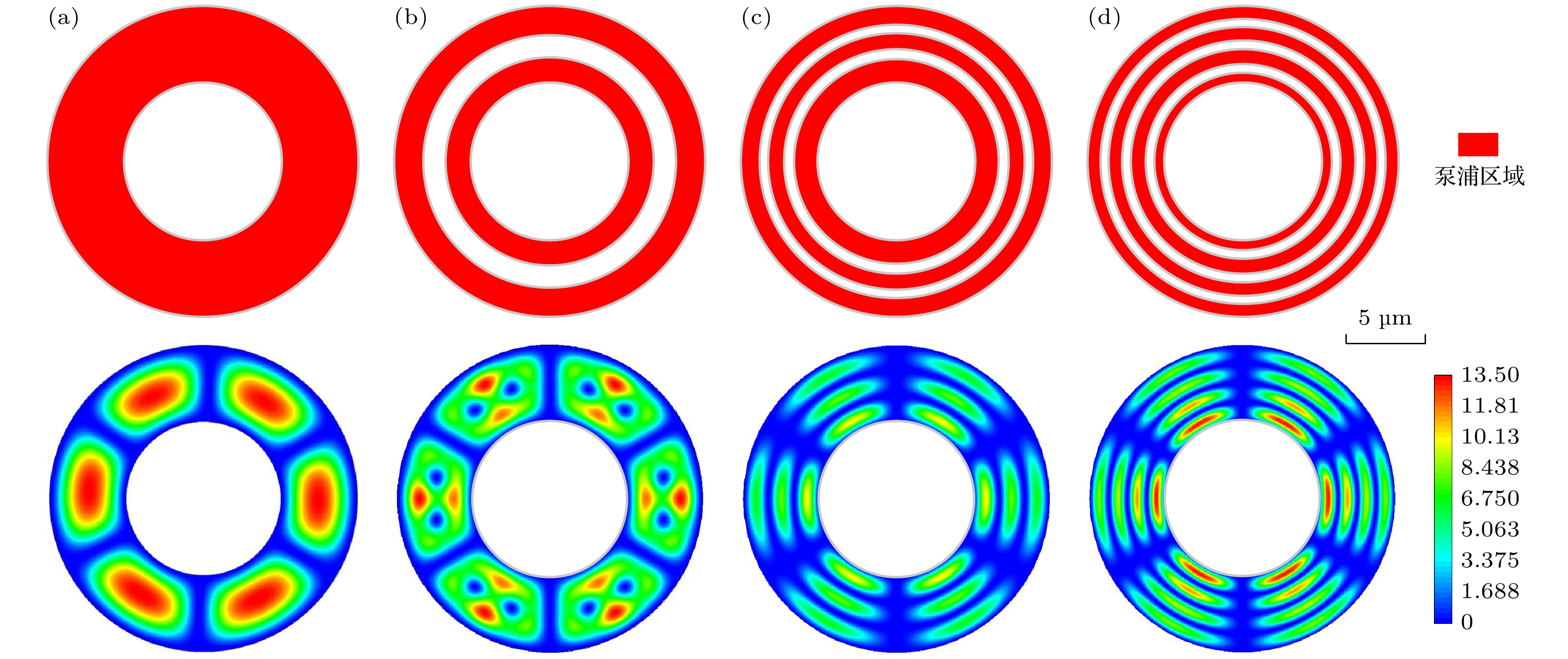-
微腔激子极化激元由于具有较轻的有效质量, 很容易实现玻色-爱因斯坦凝聚(Bose-Einstein condensate, BEC), 其在外界驱动下产生的陀螺效应具有广阔的应用前景. 本文研究了微腔激子极化激元在环形光束泵浦下微腔半径以及泵浦参数对体系演化的影响. 从单分量的Gross-Pitaevskii方程出发, 对环形微腔中的激子极化激元BEC体系的演化过程进行研究. 通过数值模拟研究了在环形微腔中保持体系稳定演化的最大涡旋叠加态花瓣数与微腔半径的关系, 分析了不同形式的环形光束泵浦作用下激子极化激元体系的演化情况, 发现在微米量级的微腔半径下, 特定形式的单环泵浦和多环泵浦能够使得微腔容纳更高阶的激子极化激元稳定涡旋叠加态的存在. 研究结果表明, 在一定的泵浦驱动条件下, 微腔半径的大小与体系能容纳的涡旋叠加态花瓣数上限之间是线性正相关的, 并且在改变泵浦激光构型时能够突破这一上限, 产生高阶、多重的涡旋叠加态.Owing to its light effective mass, polariton can easily realize Bose-Einstein condensates (BEC) and can also produce gyro effect under external drive. Therefore, it has a promising application prospect. Based on the Gross-Pitaevskii equation, the evolution of the exciton polaron BEC system in the annular microcavity is studied. Two key parameters affecting the characteristics of the exciton polaron system, namely the size of the microcavity and the configuration of the ring-shaped pumped beam, are investigated. The size of microcavity often directly affects the volume and power consumption of integrated devices. In addition, the number of coherent petals of exciton polariton superposition state matter wave propagated in microcavity is closely related to the precision and sensitivity of gyro, and the size of microcavity has a direct effect on the number of coherent petals. At the same time, whether the pumping region is continuous or not also has a key effect on the evolution of the system, and different pump configurations will affect the evolutions of the system. We find that in the microcavity radius on a micron scale, the annular microcavity can excite the petal of vortex superposition state when pumped by pumping light, and the petals can be stable, but circular cavity with a certain radius can “accommodate” a limited vortex quantum number, when vortex quantum number is too large, the system will be unstable and unable to support the formation of stable petals. However, with the increase of the radius of the annular microcavity, the superposition petal number of the exciton polariton system contained in the annular region will also increase, and the maximum petal number contained in the exciton polariton system has a positive linear correlation with the inner radius of the annular microcavity. At the same time, we find that when the pump laser configuration is changed, the system will evolve into a special form of steady state. The calculation results show that when microcavity parameters are the same but for only changing the radial width of single pump, the number of petals obtained is three times that before changing the radial width. In such a case, the number of superposition petals not only exceeds the previously calculated maximum number of petals accommodated by the annular cavity under the radius but also there appear the multiple petals combined radially. Under the double-ring pump system, changing the width of the hollow ring may produce not only the new exciton polariton condensation in the hollow ring, but also vortex states in the original petal. Under each of the three-ring and four-ring pumping condition, the evolution of the system finally presents a multi-petal state in the radial direction. Because these vortex superposition states contain the information about the density and the phase, it has important guiding significance for designing the new system of gyroscope. Therefore, these special evolutionary results open a new direction for studying the new system gyroscope.
-
Keywords:
- quantum vortex gyroscope /
- exciton polaron /
- superposition vortex states /
- ring-shaped pump
[1] Hopfield J J 1958 Phys. Rev. 112 1555
 Google Scholar
Google Scholar
[2] Hopfield J J, Thomas D G 1965 Phys. Rev. Lett. 15 22
 Google Scholar
Google Scholar
[3] Khitrova G, Gibbs H M, Jahnke F, Kira M, Koch S W 1999 Rev. Mod. Phys. 71 1591
 Google Scholar
Google Scholar
[4] Wouters M, Carusotto I 2007 Phys. Rev. Lett. 99 140402
 Google Scholar
Google Scholar
[5] Kéna-Cohen S, Maier S A, Bradley D D C 2013 Adv. Opt. Mater. 1 827
 Google Scholar
Google Scholar
[6] Lidzey D G, Bradley D D C, Skolnick M S, Virgili T, Walker S, Whittaker D M 1998 Nature 395 53
 Google Scholar
Google Scholar
[7] Weisbuch C, Nishioka M, Ishikawa A, Arakawa Y 1992 Phys. Rev. Lett 69 3314
 Google Scholar
Google Scholar
[8] Su R, Ghosh S, Wang J, Liu S, Diederichs C, Liew T C H, Xiong Q 2020 Nat. Phys. 16 301
 Google Scholar
Google Scholar
[9] Volkov V V, Oliver D J, Perry C C 2020 Nat. Commun. 11 4908
 Google Scholar
Google Scholar
[10] Kéna-Cohen S, Forrest S R 2010 Nat. Photonics 4 371
 Google Scholar
Google Scholar
[11] Xie W, Dong H, Zhang S, Sun L, Zhou W, Ling Y, Lu J, Shen X, Chen Z 2012 Phys. Rev. Lett. 108 166401
 Google Scholar
Google Scholar
[12] Daskalakis K S, Maier S A, Murray R, Kena-Cohen S 2014 Nat. Mater. 13 271
 Google Scholar
Google Scholar
[13] Su R, Diederichs C, Wang J, Liew T C H, Zhao J, Liu S, Xu W, Chen Z, Xiong Q 2017 Nano Lett. 17 3982
 Google Scholar
Google Scholar
[14] Su R, Wang J, Zhao J, Xing J, Zhao W, Diederichs C, Liew T, Xiong Q 2018 Sci. Adv. 4 0244
 Google Scholar
Google Scholar
[15] Dusel M, Betzold S, Egorov O A, Klembt S, Ohmer J, Fischer U, Hofling S, Schneider C 2020 Nat. Commun. 11 2863
 Google Scholar
Google Scholar
[16] Christopoulos S, von Hogersthal G B, Grundy A J, Lagoudakis P G, Kavokin A V, Baumberg J J, Christmann G, Butte R, Feltin E, Carlin J F, Grandjean N 2007 Phys. Rev. Lett. 98 126405
 Google Scholar
Google Scholar
[17] Ren J, Liao Q, Huang H, Li Y, Gao T, Ma X, Schumacher S, Yao J, Bai S, Fu H 2020 Nano Lett. 20 7550
 Google Scholar
Google Scholar
[18] Hu J, Kim S, Schneider C, Höfling S, Deng H 2020 Phys. Rev. Appl. 14 044001
 Google Scholar
Google Scholar
[19] Maître A, Lerario G, Medeiros A, Claude F, Glorieux Q, Giacobino E, Pigeon S, Bramati A 2020 Phys. Rev. X 10 041028
 Google Scholar
Google Scholar
[20] Alperin S N, Berloff N G 2021 Optica 8 301
 Google Scholar
Google Scholar
[21] Wang J, Xu H, Su R, Peng Y, Wu J, Liew T C H, Xiong Q 2021 Light Sci. Appl. 10 45
 Google Scholar
Google Scholar
[22] Berger B, Schmidt D, Ma X, Schumacher S, Schneider C, Höfling S, Aßmann M 2020 Phys. Rev. B 101 245309
 Google Scholar
Google Scholar
[23] 任元 中国专利 2016103181578 [2019-2-1]
Ren Y Chinese Patent 2016103181578 [2019-2-1] (in Chinese)
[24] 陈海军, 任元, 王华, 汤国志, 刘通 2019 原子与分子物理学报 36 290
 Google Scholar
Google Scholar
Chen H J, Ren Y, Wang H, Tang G Z, Liu T 2019 J. At. Mol. Phys. 36 290
 Google Scholar
Google Scholar
[25] 吴昊, 任元, 刘通, 王元钦, 刑朝洋 2020 物理学报 69 230303
 Google Scholar
Google Scholar
Wu H, Ren Y, Liu T, Wang Y Q, Xing C Y 2020 Acta Phys. Sin. 69 230303
 Google Scholar
Google Scholar
[26] Dreismann A, Cristofolini P, Balili R, Christmann G, Pinsker F, Berloff N G, Hatzopoulos Z, Savvidis P G, Baumberg J J 2014 Proc. Natl. Acad. Sci. U. S. A. 111 8770
 Google Scholar
Google Scholar
[27] 张用友 2009 博士学位论文 (南京: 南京大学)
Zhang Y Y 2009 Ph. D. Dissertation (Nanjing: Nanjing University) (in Chinese)
-
图 1 涡旋量子数
$l = 3, {\text{ 5}}, {\text{ 8}}$ 时的计算结果 (a)激子极化激元体系在演化时间从0到$100\;\hbar /{\text{meV}}$ 的总粒子数变化图; (b), (c), (d)涡旋量子数$l = 3, {\text{ 5, 8}}$ 时激子极化激元体系在$t = 100\;\hbar /{\text{meV}}$ 时的粒子数密度分布情况Fig. 1. Calculated results of vortex quantum number
$ l=3, \text{ 5}, \text{ 8} $ : (a) Total particle number of exciton polariton system changes from 0 to$100\;\hbar /{\text{meV}}$ in evolution time; (b), (c), (d) particle number density distribution of exciton polariton system at$t = 100\;\hbar /{\text{meV}}$ with the vortex quantum number$l = 3, {\text{ 5, 8}}$ .图 2 大半径下激子极化激元体系在
$l = 8$ 时的演化图像 (a)$t = 100\;\hbar /{\text{meV}}$ 时, 体系的粒子数密度分布; (b)$t = 100\;\hbar /{\text{meV}}$ 时刻之前体系总粒子数的演化情况Fig. 2. Evolution image of the exciton polariton system with a large radius at
$l = 8$ : (a) Particle number density distribution of the system at$t = 100\;\hbar /{\text{meV}}$ ; (b) evolution of the total particle number of the system before$t = 100\;\hbar /{\text{meV}}$ .图 3 在改变环形微腔半径后, 计算分析得到的对应体系下的最大承载花瓣数 (a)环形泵浦半径与能容纳的最大花瓣数的关系, 环形微腔宽度统一为
$5\;{\text{μ}}{\rm{m}}$ , 横坐标是环形微腔的内半径, 纵坐标是能够容纳的最大花瓣数. 点b, c, d分别是图(a)中的3个取值点, 对应的环形微腔内半径分别为$8$ ,$15$ 和$22\;{\text{μ}}{\rm{m}}$ . (b), (c), (d) 3 个取值点在演化时间$t = 100\;\hbar /{\text{meV}}$ 时的粒子数密度分布.Fig. 3. After changing the radius of the annular microcavity, the calculated maximum number of bearing petals in the corresponding system. (a) Relationship between the annular pumping radius and the maximum number of petals that can be accommodated. The width of the annular microcavity is
$5\;{\text{μ}}{\rm{m}}$ , the abscess is the inner radius of the annular microcavity, and the ordinate is the maximum number of petals that can be accommodated. Points b, c and d are the three value points in panel (a) respectively, which correspond to the radii of the annular microcavity of$8$ ,$15$ and$22\;{\text{μ}}{\rm{m}}$ respectively. (b), (c), (d) Particle number density distribution of the three value points at evolution time$t = 100\;\hbar /{\text{meV}}$ .图 4 泵浦区域为
$5—7.5\;{\text{μ}}{\rm{m}}$ 的单环泵浦下体系的演化过程, 即(a)$t = 0\;\hbar /{\text{meV}}$ , (b)$ t = 60\;\hbar /{\text{meV}} $ , (c)$t = 100\;\hbar /{\text{meV}}$ , (d)$t = 160\;\hbar /{\text{meV}} $ 时体系的粒子数密度图Fig. 4. Evolution of a single-loop pumping system with a pumping region of
$5-7.5\;{\text{μ}}{\rm{m}}$ . Panels (a), (b), (c) and (d) correspond to the particle number density diagram of the system at$t = 0\;\hbar /{\text{meV}}$ ,$ 60\;\hbar /{\text{meV}} $ ,$ 100\;\hbar /{\text{meV}} $ and$ 160\;\hbar /{\text{meV}} $ , respectively.图 5 多环泵浦下的涡旋叠加态演化情况, 图(a), (b), (c), (d)分别表示单环、双环、三环、四环情况下的计算结果, 其中第一行为构造的多环泵浦区域示意图, 红色区域表示泵浦区域, 白色区域表示构造出的空环带; 第二行对应于多环泵浦下体系演化的粒子数密度分布, 取值时刻为
$t = 100\;\hbar /{\text{meV}}$ Fig. 5. Evolution of vortex superposition state under multiloop pump. (a), (b), (c) and (d) show the calculation results of single-ring, double-ring, three-ring, and four-ring respectively. The first shows the schematic diagram of the multi-ring pumping region constructed, with the red region representing the pumping region and the white region representing the empty ring zone constructed. The second row corresponds to the particle number density distribution of the system evolution under the multi-loop pump, and the value time is
$t = 100\;\hbar /{\text{meV}}$ .图 6 不同空环带宽度下双环泵浦时激子场演化的分析, 图(a), (b), (c)分别对应于空环带区域为
$6.6—8.4\;{\text{μ}}{\rm{m}}$ ,$6.9—8.1\;{\text{μ}}{\rm{m}}$ 和$7.2—7.8\;{\text{μ}}{\rm{m}}$ 时体系演化的粒子数密度分布, 取值时刻为$t = 100\;\hbar /{\text{meV}}$ Fig. 6. Analysis of the evolution of exciton field under double-ring pump with different void band widths. (a), (b) and (c) correspond to the particle number density distribution of the system evolution when the void band region is
$6.6-8.4\;{\text{μ}}{\rm{m}}$ ,$6.9-8.1\;{\text{μ}}{\rm{m}}$ and$7.2-7.8\;{\text{μ}}{\rm{m}}$ respectively, and the value time is t = 100$ \hbar /{\text{meV}} $ . -
[1] Hopfield J J 1958 Phys. Rev. 112 1555
 Google Scholar
Google Scholar
[2] Hopfield J J, Thomas D G 1965 Phys. Rev. Lett. 15 22
 Google Scholar
Google Scholar
[3] Khitrova G, Gibbs H M, Jahnke F, Kira M, Koch S W 1999 Rev. Mod. Phys. 71 1591
 Google Scholar
Google Scholar
[4] Wouters M, Carusotto I 2007 Phys. Rev. Lett. 99 140402
 Google Scholar
Google Scholar
[5] Kéna-Cohen S, Maier S A, Bradley D D C 2013 Adv. Opt. Mater. 1 827
 Google Scholar
Google Scholar
[6] Lidzey D G, Bradley D D C, Skolnick M S, Virgili T, Walker S, Whittaker D M 1998 Nature 395 53
 Google Scholar
Google Scholar
[7] Weisbuch C, Nishioka M, Ishikawa A, Arakawa Y 1992 Phys. Rev. Lett 69 3314
 Google Scholar
Google Scholar
[8] Su R, Ghosh S, Wang J, Liu S, Diederichs C, Liew T C H, Xiong Q 2020 Nat. Phys. 16 301
 Google Scholar
Google Scholar
[9] Volkov V V, Oliver D J, Perry C C 2020 Nat. Commun. 11 4908
 Google Scholar
Google Scholar
[10] Kéna-Cohen S, Forrest S R 2010 Nat. Photonics 4 371
 Google Scholar
Google Scholar
[11] Xie W, Dong H, Zhang S, Sun L, Zhou W, Ling Y, Lu J, Shen X, Chen Z 2012 Phys. Rev. Lett. 108 166401
 Google Scholar
Google Scholar
[12] Daskalakis K S, Maier S A, Murray R, Kena-Cohen S 2014 Nat. Mater. 13 271
 Google Scholar
Google Scholar
[13] Su R, Diederichs C, Wang J, Liew T C H, Zhao J, Liu S, Xu W, Chen Z, Xiong Q 2017 Nano Lett. 17 3982
 Google Scholar
Google Scholar
[14] Su R, Wang J, Zhao J, Xing J, Zhao W, Diederichs C, Liew T, Xiong Q 2018 Sci. Adv. 4 0244
 Google Scholar
Google Scholar
[15] Dusel M, Betzold S, Egorov O A, Klembt S, Ohmer J, Fischer U, Hofling S, Schneider C 2020 Nat. Commun. 11 2863
 Google Scholar
Google Scholar
[16] Christopoulos S, von Hogersthal G B, Grundy A J, Lagoudakis P G, Kavokin A V, Baumberg J J, Christmann G, Butte R, Feltin E, Carlin J F, Grandjean N 2007 Phys. Rev. Lett. 98 126405
 Google Scholar
Google Scholar
[17] Ren J, Liao Q, Huang H, Li Y, Gao T, Ma X, Schumacher S, Yao J, Bai S, Fu H 2020 Nano Lett. 20 7550
 Google Scholar
Google Scholar
[18] Hu J, Kim S, Schneider C, Höfling S, Deng H 2020 Phys. Rev. Appl. 14 044001
 Google Scholar
Google Scholar
[19] Maître A, Lerario G, Medeiros A, Claude F, Glorieux Q, Giacobino E, Pigeon S, Bramati A 2020 Phys. Rev. X 10 041028
 Google Scholar
Google Scholar
[20] Alperin S N, Berloff N G 2021 Optica 8 301
 Google Scholar
Google Scholar
[21] Wang J, Xu H, Su R, Peng Y, Wu J, Liew T C H, Xiong Q 2021 Light Sci. Appl. 10 45
 Google Scholar
Google Scholar
[22] Berger B, Schmidt D, Ma X, Schumacher S, Schneider C, Höfling S, Aßmann M 2020 Phys. Rev. B 101 245309
 Google Scholar
Google Scholar
[23] 任元 中国专利 2016103181578 [2019-2-1]
Ren Y Chinese Patent 2016103181578 [2019-2-1] (in Chinese)
[24] 陈海军, 任元, 王华, 汤国志, 刘通 2019 原子与分子物理学报 36 290
 Google Scholar
Google Scholar
Chen H J, Ren Y, Wang H, Tang G Z, Liu T 2019 J. At. Mol. Phys. 36 290
 Google Scholar
Google Scholar
[25] 吴昊, 任元, 刘通, 王元钦, 刑朝洋 2020 物理学报 69 230303
 Google Scholar
Google Scholar
Wu H, Ren Y, Liu T, Wang Y Q, Xing C Y 2020 Acta Phys. Sin. 69 230303
 Google Scholar
Google Scholar
[26] Dreismann A, Cristofolini P, Balili R, Christmann G, Pinsker F, Berloff N G, Hatzopoulos Z, Savvidis P G, Baumberg J J 2014 Proc. Natl. Acad. Sci. U. S. A. 111 8770
 Google Scholar
Google Scholar
[27] 张用友 2009 博士学位论文 (南京: 南京大学)
Zhang Y Y 2009 Ph. D. Dissertation (Nanjing: Nanjing University) (in Chinese)
计量
- 文章访问数: 6267
- PDF下载量: 103
- 被引次数: 0






















 下载:
下载:









































